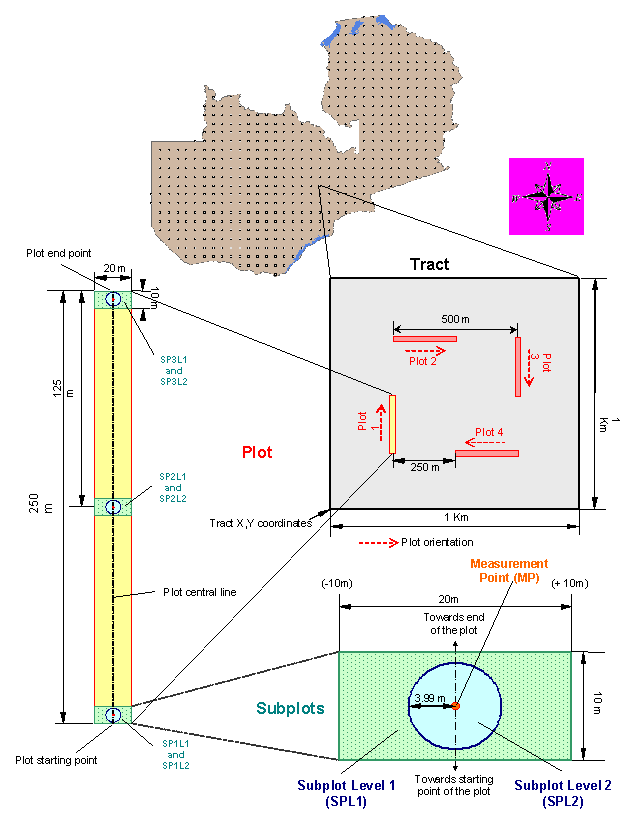


The sampling design adopted for the national forest resources assessment is systematic. Tracts are selected at least at the intersection of every degree of the latitude/longitude grid.
Depending on country’s situations and information needs, higher sampling intensity may be applied. Stratification may be adopted in situations where stable strata such as ecological zones are deemed to improve the design.
The example of Cameroon is shown in Table 1 and Figure 1 below. The systematic and stratified sampling design applied (30 minutes latitude by 15 minutes longitude in stratum 1 and 30 minutes latitude by 30 minutes longitude in stratum 2) resulted in the selection of 236 tracts nation-wide.
Table 1. Tract density per stratum in Cameroon
Stratum |
Tract number |
Distance between tracts | |
(minutes) |
(km) | ||
1 |
167 |
lat 30‘ x lon 15‘ |
km 50 N X 25 km E |
2 |
69 |
lat 30‘ x lon 30‘ |
km 50 N X 50 km E |
TOTAL |
236 |
||
Figure 1. Distribution of tracts for the national forest inventory of Cameroon
Forest and tree inventory data is exclusively collected within the limits of the tract. Data is collected through observations, measurements and interviews at different levels: within the tracts, which represents the highest level, then in smaller sub-units (plots and subplots) demarcated within the tracts.
A tract is a square of 1 km x 1 km (see figure 2). The co-ordinates of the south-west corner of the tracts correspond to those of the points selected in the systematic sampling frame. Each tract contains four field plots.
The plots are rectangles measuring 20 m wide and 250 m long. They start at each corner of an inner 500 m square (same centre as tract’s) and are numbered clockwise from 1 to 4 as shown in figure 2. The location and orientation of the 4 plots are given in Table 2.
Table 2. Plot location and orientation
Plot |
Location of the starting point of the plot, within the 500 m inner square |
Orientation |
Bearing |
Plot 1 |
South-West corner |
South-North |
0 / 360 degrees |
Plot 2 |
North-West corner |
West-East |
90 degrees |
Plot 3 |
North-East corner |
North-South |
180 degrees |
Plot 4 |
South-East corner |
East-West |
270 degrees |
Three pairs of subplots are delimited within each plot. They correspond to two different data collection levels: 3 rectangular subplots (SPL1) measuring 20m x 10m, corresponding to level 1, and 3 circular subplots (SPL2) with a radius of 3.99 m, corresponding to level 2, located in the centre of the rectangular subplots. Both subplots categories are numbered from 1 to 3, starting at the starting point of the plot. The subplots serve to measure tree regeneration (Dbh < 10 cm) and small diameter trees (10≤ Dbh < 20 cm) in forest. An edaphic and topographic measurement point is established at the centre of each subplot. When the location of the subplots falls in land use classes other than forest, they must not be demarcated.
Figure 2. Tract, plot and subplot design

Each plot is divided into land use/forest type sections (LUS) representing homogenous land use or forest type units, with variable size and shape that have been identified in the field. The classification system adopted to identify the different land use classes and forest types is described in chapter 3. Most of the data related to forest characteristics, management and resources use and users are collected within the LUS.
Figure 3. Example of land use sections (LUS) distribution within a plot

There are 4 land use sections in this plot. The red lines indicate the limits between them. LUS2 and LUS4 belong to the same Land Use class.
The specifications of the different units are summarized in Table 3. All the distances indicated are horizontal.
Table 3. Inventory unit specifications
Unit |
Shape |
Size * (area) |
Number |
Tract |
Square |
1000 m x 1000 m (1km2) |
1 |
Plot |
Rectangle |
250 m x 20 m (5000 m2) |
4/tract |
Subplot level 1 |
Rectangle |
20 m x 10 m (200 m2) |
3/plot |
Subplot level 2 |
Circular |
Radius r = 3,99 m (50 m2) |
3/plot |
Land use/forest type section (LUS) |
Variable |
Variable |
Variable |
Notes: All distances indicated are horizontal distances.